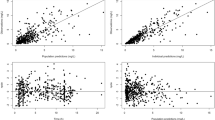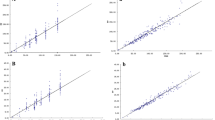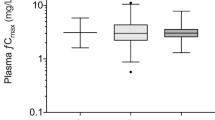Abstract
In this paper, population pharmacokinetics (PPK) and pharmacodynamics of norvancomycin in patients were investigated. The studied dataset was derived from 146 patients with confirmed or suspected gram-positive bacterial infections, as well as 20 healthy volunteers. A PPK model was developed and validated by the nonlinear mixed effect model (NONMEM) software. The norvancomycin minimum inhibitory concentrations (MICs) for the isolates from patients were determined by the agar dilution method. The best model was a two-compartment pharmacokinetic model with exponential inter-individual error and an additive residual error statistic model. The findings of the present study indicated that the change in CLcr values had different effects on drug clearance (CL). In patients with renal dysfunction (CLcr≤85 ml/min), CL (L/h)=2.54·(CLcr /50)1.20, while in patients with normal renal function (CLcr>85 ml/min), CL=6.0·(WT/60)0.52. An increased volume of peripheral distribution (V2) was observed when norvancomycin was co-administered with diuretics. Inter-individual variability in CL, V1, Q, and V2 was 35.92%, 11.40%, 0, and 79.75%, respectively. Residual variability was 3.05 mg/L. The logistic stepwise analyses revealed that only the ratio of AUC24 /MIC was a major factor which could significantly predict the clinical outcome and bacterial eradication in patients. As the AUC24/MIC ratio was >579.90 for staphylococcal infection and >637.67 for enterococcal infections, approximately 95% of patients would be predicted to achieve a cured clinical outcome. In conclusion, AUC24/MIC should be a major pharmacokinetics/pharmacodynamics (PK/PD) parameter to predict the clinical efficacy of norvancomycin. An optimized regimen of norvancomycin can be simulated and developed for different subgroups of patients who have special physiologic and pathologic conditions.


Similar content being viewed by others
Reference
Morgan M, Evans-Williams D, Salmon R, Hosein I, Looker DN, Howard A (2000) The population impact of MRSA in a country: the national survey of MRSA in Wales, 1997. J Hosp Infect 44(3):227–239
Zhang YY (2001) Development of antibiotics in the treatment of gram-positive cocci infections. Chin J Infect Chemother 1(1):50–53
Shanghai Surveillance of Bacterial Resistance Working Group (2002) Surveillance of bacterial resistance in Shanghai. Chin J Infect Chemother 2(1):1–9
Wang F (2006) CHINET 2005 surveillance of bacterial resistance in China. Chin J Infect Chemother 6(5):289–295
Wang F (2004) Vancomycin and norvancomycin. In: Wang F (ed) Practical anti-infectious therapeutics. People’s Medical Publishing House, Beijing, pp 281–283
Liu Y, Wu JF, Xiao ZL, Sheng RY, Lu XJ, Chen Y, Zhang YY (2004) The adverse reactions of parenteral norvancomycin in 1031 patients. Chin J Intern Med 43(11):815–819
Buelga DS, Gatta MMF, Herrera EV, Dominguez-Gil A, García MJ (2005) Population pharmacokinetic analysis of vancomycin in patients with hematological malignancies. Antimicrob Agents Chemother 49(12):4934–4941
Kimura T, Sunakawa K, Matsuura N, Kubo H, Shimada S, Yago K (2004) Population pharmacokinetics of arbekacin, vancomycin, and panipenem in neonates. Antimicrob Agents Chemother 48(4):1159–1167
Sheiner LB, Grasela TH Jr (1991) An introduction to mixed effect modeling: concepts, definitions, and justification. J Pharmacokinet Biopharm 19(Suppl):11S–24S
Yasuhara M, Iga T, Zenda H, Okumura K, Oguma T, Yano Y, Hori R (1998) Population pharmacokinetics of vancomycin in Japanese adult patients. Ther Drug Monit 20(2):139–148
Zhang Z, Zhai SD (2004) The development of nonlinear mixed effects model in study of pharmacokinetics and pharmacodynamics. Foreign Medical Sciences Section on Pharmacy 31(4):236–240
Zhang J, Hu JY, Yu JC, Cao GY, Shi YG, Zhang YY (2003) Clinical pharmacokinetics and therapeutic drug monitoring of norvancomycin. Chin J Infect Chemother 3(4):202–205
Craig WA (1998) Pharmacokinetic/pharmacodynamic parameters: rationale for antibacterial dosing of mice and men. Clin Infect Dis 26(1):1–10, quiz 11–12
Frimodt-Møller N (2002) How predictive is PK/PD for antibacterial agents. Int J Antimicrob Agents 19:333–339
Li C, Kuti JL, Nightingale CH, Mansfield DL, Dana A, Nicolau DP (2005) Population pharmacokinetics and pharmacodynamics of piperacillin/tazobactam in patients with complicated intra-abdominal infection. J Antimicrob Chemother 56(2):388–395
Van Wart S, Phillips L, Ludwig EA, Russo R, Gajjar DA, Bello A, Ambrose PG, Costanzo C, Grasela TH, Echols R, Grasela DM (2004) Population pharmacokinetics and pharmacodynamics of garenoxacin in patients with community-acquired respiratory tract infections. Antimicrob Agents Chemother 48(12):4766–4777
Zhanel GG (2001) Influence of pharmacokinetic and pharmacodynamic principles on antibiotic selection. Curr Infect Dis Rep 3:29–34
Zhong SL, Huang M, Zhao XL (2003) Pharmacokinetic/pharmacodynamic parameters: rational for antimicrobial agents dose regimen. Chin J Infect Chemother 3(3):177–180
Moise-Broder PA, Forrest A, Birmingham MC, Schentag JJ (2004) Pharmacodynamics of vancomycin and other antimicrobials in patients with Staphylococcus aureus lower respiratory tract infections. Clin Pharmacokinet 43(13):925–942
Acknowledgments
This work was supported by HTRDP (863 Project) from the Ministry of Science and Technology of the People’s Republic of China.
Author information
Authors and Affiliations
Corresponding author
Rights and permissions
About this article
Cite this article
Zhang, J., Zhang, Y., Shi, Y. et al. Population pharmacokinetic and pharmacodynamic modeling of norvancomycin. Eur J Clin Microbiol Infect Dis 27, 275–284 (2008). https://doi.org/10.1007/s10096-007-0435-9
Received:
Accepted:
Published:
Issue Date:
DOI: https://doi.org/10.1007/s10096-007-0435-9




